The activation energy (Ea) is a crucial parameter in understanding the kinetics of chemical reactions. It represents the minimum energy required for a reaction to occur, and its determination is essential in various fields, including chemistry, biology, and materials science. This comprehensive guide will walk you through the step-by-step process of finding the activation energy using temperature and rate constant data.
Understanding the Arrhenius Equation
The Arrhenius equation is the fundamental relationship that connects the rate constant (k), temperature (T), and activation energy (Ea) of a chemical reaction. The equation is expressed as:
k = A * e^(-Ea/RT)
where:
– k is the rate constant of the reaction
– A is the pre-exponential factor, which represents the frequency of collisions between reactant molecules
– Ea is the activation energy of the reaction
– R is the universal gas constant (8.314 J/(mol·K))
– T is the absolute temperature in Kelvin (K)
By rearranging the Arrhenius equation, we can determine the activation energy using either a graphical or an algebraic approach.
Graphical Determination of Activation Energy

To find the activation energy graphically, we can take the natural logarithm of both sides of the Arrhenius equation:
ln k = -Ea/RT + ln A
This equation can be further rearranged to the form of a straight line:
ln k = -(Ea/R) * (1/T) + ln A
The slope of the line is -Ea/R, which allows us to calculate the activation energy.
Example Calculation:
Let’s consider the following data for the reaction H2(g) + I2(g) → 2HI(g):
| Temperature (K) | Rate Constant, k (s^-1) |
|---|---|
| 375 | 1.68 × 10^-5 |
| 400 | 3.5 × 10^-5 |
| 500 | 4.2 × 10^-4 |
| 600 | 2.11 × 10^-3 |
We can calculate the values of ln k and 1/T, and plot them on a graph:
| 1/T (K^-1) | ln k |
|---|---|
| 0.002667 | -10.9941 |
| 0.0025 | -10.2602 |
| 0.002 | -7.77526 |
| 0.001667 | -6.16107 |
The slope of the line is -Ea/R, so we can solve for the activation energy:
Ea = -slope × R = -(-8 × 10^-5) × 8.314 J/(mol·K) = 66.512 J/mol
Therefore, the activation energy for this reaction is 66.512 J/mol.
Algebraic Determination of Activation Energy
Alternatively, the activation energy can be calculated algebraically if the rate constant (k) is known at two different temperatures (T1 and T2).
We can start with the Arrhenius equation for the two temperatures:
ln k1 = -Ea/(RT1) + ln A
ln k2 = -Ea/(RT2) + ln A
By subtracting the first equation from the second, we can eliminate the pre-exponential factor (ln A):
ln k2 - ln k1 = -Ea/RT2 + Ea/RT1
Solving for the activation energy, we get:
Ea = (ln k2 - ln k1) / ((1/RT2) - (1/RT1))
Example Calculation:
Let’s use the following data for the reaction H2(g) + I2(g) → 2HI(g):
- At 326°C (599 K), the rate constant is 5.4 × 10^-4 M^-1s^-1.
- At 410°C (683.15 K), the rate constant is 2.8 × 10^-2 M^-1s^-1.
Plugging the values into the equation:
Ea = (ln(2.8 × 10^-2) - ln(5.4 × 10^-4)) / ((1/(8.314 J/(mol·K) × 683.15 K)) - (1/(8.314 J/(mol·K) × 599 K)))
= 1.60 × 10^5 J/mol
Therefore, the activation energy for this reaction is 1.60 × 10^5 J/mol.
Additional Considerations
- The Arrhenius equation assumes that the activation energy is independent of temperature. However, in some cases, the activation energy may vary with temperature, and more complex models may be required.
- The pre-exponential factor (A) can also provide insights into the reaction mechanism, as it is related to the frequency of collisions between reactant molecules.
- Experimental factors, such as the accuracy of temperature and rate constant measurements, can affect the reliability of the activation energy calculation.
- The activation energy can be used to predict the rate of a reaction at different temperatures, as well as to understand the effect of catalysts on the reaction kinetics.
Conclusion
Determining the activation energy of a chemical reaction is a crucial step in understanding its kinetics and thermodynamics. By using the Arrhenius equation and the graphical or algebraic methods presented in this guide, you can accurately calculate the activation energy from temperature and rate constant data. This knowledge can be applied in various fields, from chemistry and materials science to biology and engineering, to optimize reaction conditions, design catalysts, and predict the behavior of complex systems.
References
- Activation Energy and the Arrhenius Equation | Introductory Chemistry
- Calculate Activation Energy from Rate Constants and Temperatures
- Activation Energy Two-Point Form of the Arrhenius Equation
- Activation Energy and Rate – Chemistry LibreTexts

The lambdageeks.com Core SME Team is a group of experienced subject matter experts from diverse scientific and technical fields including Physics, Chemistry, Technology,Electronics & Electrical Engineering, Automotive, Mechanical Engineering. Our team collaborates to create high-quality, well-researched articles on a wide range of science and technology topics for the lambdageeks.com website.
All Our Senior SME are having more than 7 Years of experience in the respective fields . They are either Working Industry Professionals or assocaited With different Universities. Refer Our Authors Page to get to know About our Core SMEs.